Most people will experience painful inflammation at least once in their life. It is believed that acne mainly occurs in young people. However, painful acne can appear at any age.
They are difficult to treat because they are located deep under the skin. These inflammations are called internal, they cannot be pressed. They can appear on different parts of the face and body. Pain occurs due to the rapid development of compaction and inflammation.
Causes
Painful rashes can form for both external and internal reasons:
- Incorrectly selected cosmetics or care. If you don't wash off your makeup well, in 99% of cases it will cause painful acne.
- Accelerated growth of hair follicles.
- Hormonal disbalance. Usually in adolescents of any gender or in women during menstruation or menopause. Also due to stress.
- The presence of a large number of bacteria.
- Subcutaneous mite (demodex).
- Increased sebum secretion. During the day, dirt, dust gets into open pores and mixes with sebum.
- Diseases of internal organs. Most often it is associated with the gastrointestinal tract.
Risk factors
Before starting treatment, it is necessary to determine what could provoke painful inflammation:
- poor nutrition;
- allergic reactions;
- presence of bad habits;
- exposure to cold (frost, wind, draft);
- frequent consumption of fatty, fried, spicy foods, sweets, dairy products;
- heredity;
- side effects of certain medications;
- changes in hormonal levels;
- weakening of the immune system.
What diseases are warned about?
Rashes can appear on different parts of the body. A certain area of skin with painful pimples signals a disease.
On the back
Painful rashes on this area of the skin warn of problems with hormones. In women, they may occur in connection with menstruation. In men, acne on the back appears due to changes in the body or long-term use of steroids.
Other diseases associated with back inflammation:
- gastrointestinal disorders;
- problems with the genitourinary system;
- diseases of the spine.
On the face
Depending on the part of the face covered with acne, the disease can be determined:
- Acne around the mouth and in the center of the chin indicates problems in the stomach or small intestine.
- Rashes on the sides of the chin indicate diseases of the genitourinary system or hormonal imbalance.
- Pimples between the eyebrows indicate liver problems.
- Ears with inflammation are explained by impaired kidney function.
- Inflammations on the cheeks warn of a problem with the lungs.
On the head
Pimples located along the hairline indicate bladder disease.
Rashes on the scalp in most cases indicate a bacterial infection.
On the forehead
On the upper part of the forehead - a problem with the bladder or colon. Toxins do not have time to be eliminated and poison the body.
The lower part of the forehead shows disturbances in sleep and the functioning of the nervous system.
On the nose
Pimples on the nose indicate diseases of the cardiovascular system.
On the butt
Causes of acne on the butt:
- passive lifestyle;
- hormonal imbalances;
- hypothermia of the body;
- allergic reactions.
Symptoms
Regardless of the cause of inflamed acne, the symptoms will be the same:
- painful sensations;
- redness, inflammation;
- tubercles and compactions;
- after 1-2 weeks, white pus appears and the pain decreases.
Pimples on the head are accompanied by itching and irritation.
How to get rid of black pimples on nose? The answer is here.
Structure of the boil
What does an inflamed, painful pimple consist of:
- Dirt, dust gets into the wound or open pore and mixes with sebum.
- An internal abscess forms under the skin.
- With the active proliferation of bacteria, inflammation increases.
- This happens in order to protect the body from the penetration of these microorganisms inside.
- The pimple matures completely in 2-3 weeks, it is ready for opening.
How to get rid
Drug treatment
There are many pharmaceutical products to combat internal acne:
- Vishnevsky ointment accelerates the maturation of the subcutaneous tissue several times. Adsorbents help quickly draw pus to the surface for subsequent removal. The ointment is applied at night and secured with a band-aid. In the best case, the pimple can be removed the next morning. More than three procedures will not be needed.
- Levomekol ointment disinfects the inflamed area and heals the wound. When applied to the rash several times a day, it goes away in 4-6 days.
- Gel Baziron AS is used for a course of 3 months. The product is applied 2 times a day, pointwise to each inflammation. After the course, acne should disappear completely.
- Dalacin - contains an antibiotic, you should first consult a doctor. Used in a course of 2 weeks. After this, an addiction effect sets in and the next course can be repeated after 6 months.
- Zinc ointment dries out inflammation well. It is applied 5-7 times a day. The effect is noticeable within a week.
Cosmetic procedures
In combination with home care, salon procedures will not be superfluous.
They act more deeply and eliminate the cause:
- Acid peels exfoliate dead epidermal cells and accelerate skin renewal. The process of maturation of painful acne will occur faster.
- Microdermabrasion removes dead skin cells from the surface of the skin, improves microcirculation in tissues, and accelerates blood circulation.
- Laser resurfacing removes not only acne, but also marks and scars. The procedure itself does not leave any traces.
- Ozone therapy destroys all bacterial microorganisms, relieves inflammation and swelling.
- Mesotherapy (subcutaneous injections) is useful because the active substances immediately reach the problem area.
Medical cosmetics
It can be purchased at pharmacies.
Each manufacturer has a line to combat acne:
- La Roche-Posay Effaclar.
- Uriage Hyseac.
- Avene Cleanance.
- Vichy Normaderm.
- Bioderma Sebium.
- Duckray Ceracnyl.
Traditional methods
From improvised means you can make an effective weapon against painful subcutaneous acne:
- Cut a piece of aloe and peel off one side. Place an aspirin tablet in the middle. Place the side of the tablet on the pimple and secure with a band-aid. Leave until morning. The pus will be drawn out and the pimple can be easily removed.
- Drop 2-3 drops of water onto the activated carbon tablet, you should get a creamy thick mass. Apply to the pimple, wash off after an hour. Coal draws out all impurities and toxins, relieves inflammation.
- Mix white clay with milk, apply the paste on the face in a thin layer and leave until completely dry. Clay will dry out acne, milk will soften the skin, preventing dryness.
- Before going to bed, apply a cotton swab with iodine to each pimple. Lubricate carefully to avoid burns.
Video: Folk remedies for facial rashes
Home Recipes
Natural remedies are great for fighting internal acne:
- Mix the juice of half a lemon, half a glass of mint decoction and 1 tsp. aloe juice Wipe your face with a refreshing toner twice a day.
- Soak a cotton swab in tea tree essential oil and apply it to the rash several times a day, each time after drying.
- Mix the infusion of St. John's wort and yarrow with chamomile oil. Cut a cotton pad into small pieces, soak each one generously in the tincture, apply a lotion to each inflammation for 30-40 minutes.
- Apply grape seed oil to damp skin after washing. It will seal the water and moisturize the skin. This is the only cosmetic oil suitable for oily skin.
Useful tips
Effective and effective ways to combat painful acne:
- Sunbathing under the sun. It is necessary to use sunscreen, otherwise it will have the opposite effect.
- Drink antioxidant drinks: green tea, pomegranate juice, citrus juices, ginger tea. Eliminate coffee and black tea.
- Go to the doctor and get tested for the presence of subcutaneous mites.
- Change pillowcases every day.
What not to do with painful acne on your face
It is prohibited to use scrubs with abrasive particles. They injure the skin and spread infection everywhere.
The use of products containing large amounts of alcohol is not recommended. It dries the skin very much, causing it to secrete even more oil.
The appearance of acne on the forehead in women may have non-serious causes, or may signal the presence of a pathological process in the body. There are plenty of treatment methods for rashes. However, none of them will bring results if you do not identify the internal organ, the problems with which caused the skin blemishes.
Types of acne on the forehead
Inflammatory processes are the main causes of rashes on the forehead. The skin becomes covered with tubercles containing purulent contents. Problem areas hurt when pressed.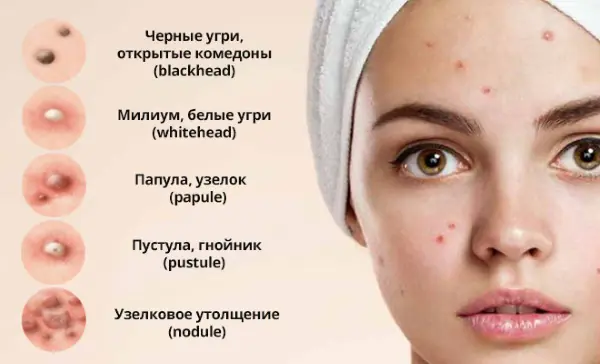
This group includes:
- Nodules: size 10-30 mm, purple, red or bluish in color. They are formed due to damage to the follicle and the penetration of its contents into the deep subcutaneous layers. The skin on the forehead at the location of the pimples, after they are removed, may become covered with scars or dark spots.
- Papule: small redness ranging from 1 to 10 mm, pink or red. At the site of such inflammation there are no scars or cicatrices during recovery.
- Cyst - purulent formation is dense to the touch. Multiple cysts are often combined into a single chain and are connected by narrow channels running deep in the tissues. After their treatment, traces of presence remain on the skin in the form of dimples, scars, scars.
- Pustule - a pimple filled with pus with a white head. They form from papules or independently.
- Comedones - skin formations of a non-inflammatory nature. They look like small bumps on the surface of the skin, white in color, making it rough. Appear in the upper layers of the skin.
- Black dots They look like ordinary dirt. The reason for the formation is the oxidation of the sebaceous glands during a reaction with oxygen. The color of the rash ranges from brown to black.
Is it possible to squeeze out
The human immune system, protecting itself from the spread of infection throughout the body, blocks the source of inflammation, protecting it from healthy tissues. The site of infection is additionally saturated with immune cells, thus supplying white blood cells to the affected area. Subcutaneous pus consists of dead leukocytes and microbes.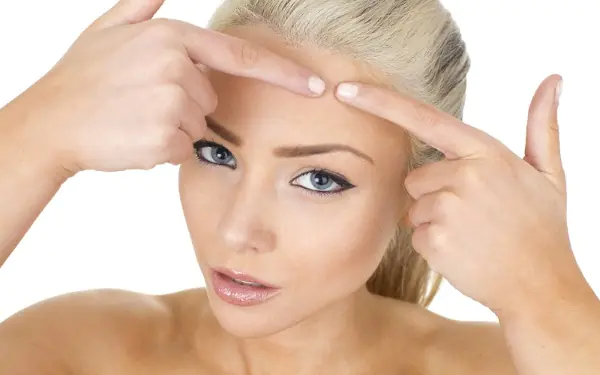
Anyone who squeezes a pimple wants to get rid of the purulent contents. If you remove the source of inflammation, the skin will heal faster, but another scenario is also possible.
Possible complications:
- sepsis - blood poisoning;
- blood clot separation - the plug formed at the site of removal of pus may come off;
- infection - extrusion increases the risk of formation of 5 similar ones in its place and nearby;
- skin trauma - consequences in the form of scars, scars, skin pigmentation and dimples.
Causes of acne
Causes acting from outside
Pimples on the forehead require special care, since their causes in women often lie in increased fat content. Large amounts of sweat and sebum have a beneficial effect on the development of pathogenic flora, bacteria and viruses. Hence, inflammation in the forehead area is more frequent.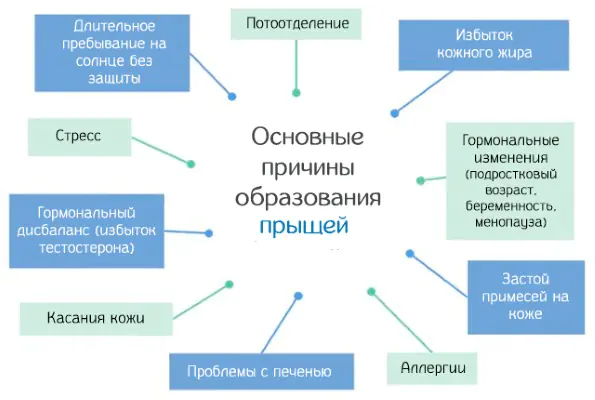
Main reasons:
- Improper care, use of cosmetic products with a composition that does not match your skin type, heavy makeup, poor cleansing clogs the pores. As a result, microbes develop in it, causing acne to grow.
- The causes of acne in the cold season lie in the regular wearing of a hat made of synthetic material.
- Overheating or hypothermia can cause problems. Wearing bangs or a bandage covering the forehead area can cause inflammation.
- Subcutaneous mite - demodex. The parasite multiplies in 3-4 days. My favorite area to live on the face is the forehead.
Internal reasons
The reasons for the appearance of acne on the forehead, hidden inside the body, include:
- An allergic reaction of the body to an irritant entering the gastrointestinal tract. The rash in this case has a pale pink color without pus inside. Problem areas often itch and peel. The most common allergens: chocolate, bee products, eggs, cocoa, coloring pigments, chemical additives, harmful and poisonous products.
- Emotional turmoil and stress. Skin problems of this nature usually occur in women aged 30 to 45 years. Pimples have different shapes and sizes, form in groups, do not cause pain, and are pink in color.
- Diseases of internal organs: Gastrointestinal tract (gastritis and pancreatitis), endocrine system disorders (diabetes, hypothyroidism), diseases of the female organs with changes in hormonal levels, diseases that impair the conductivity of the arteries.
Which organ is wrong?
The appearance of acne on the forehead may be associated with digestive problems:
- The appearance of a pimple rash on the face near the eyebrows indicates problems with the small intestine, and at the beginning of the hairline it signals diseases of the colon. The organs are unable to cope with the release of toxic substances from the body. Then the skin comes to their aid, trying to release toxins through the pores. The reasons lie in poor nutrition, dysbiosis, and overeating.

Diseases of the internal organs can cause acne to appear on the forehead and other areas of a woman’s face.
Why do they appear during pregnancy?
The occurrence of skin problems in the forehead area in pregnant women indicates the beginning of changes in the body. An increase in the hormone progesterone explains the main reason for the appearance of acne in expectant mothers. It is he who helps to cover the face with such formations. Its level rises rapidly in the first trimester and this explains the appearance of the rash in the early stages.
There are a number of other reasons:
- Lack of fluid in the body. A state of water fasting allows you to increase the concentration of hormones in the blood and provokes an increase in sebum secretion.
- Nervous shocks.
- Power failures.
- Cosmetics that are not suitable for your skin type.
- Insufficient hygiene.
Treatment with medications
It is possible to get rid of the problem if the cause of its occurrence and the factors that provoked inflammatory processes in the skin are clear:
- Stress acne requires medical treatment and regulation of stress factors. Drugs that correct a person’s psycho-emotional background: Tenoten, Afobazol, Persen.
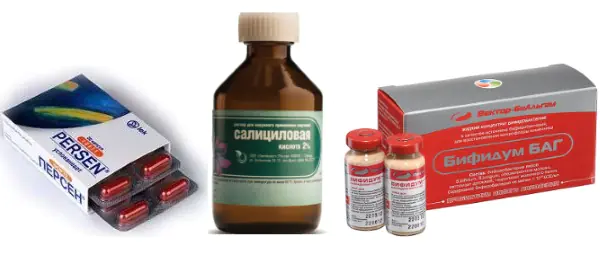
- Slagging of the intestines and the circulation of substances that poison the skin are eliminated by bacteria-containing products: Bifidum, Normobak, Narine, Yogulakt.
- If the cause is pathogenic flora, it is recommended to take drugs with antibacterial and anti-inflammatory effects: Klenzit-S, Salicylic acid, Zinerit, Baziron.
- Purulent rashes will be eliminated by Levomikol or Erythromycin ointment. They are suitable for the treatment of teenage skin problems, often accompanied by the appearance of festering, large acne.
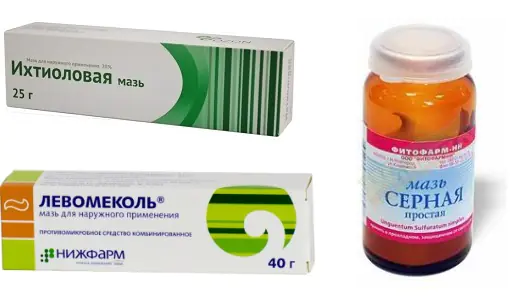
- Sulfur ointment is suitable for subcutaneous acne. Its main component has an antimicrobial and drying effect, reduces the production of subcutaneous fat.
- Ichthyol ointment applied to a purulent formation stimulates its maturation.
Antibiotics
Pimples on the forehead (causes in women can provoke damage to other parts of the body - shoulders, chest and back) are treated with antibiotics.
The following medications are common against acne:
- Erythromycin - a macrolide that has an antimicrobial effect on the skin. Statistics show that its effectiveness is 30% in treating this disease. It has a comprehensive effect on acne by destroying microbes that cause the development of rashes.
- Clindamycin - an antibiotic of the lincosamide group. It is similar in action and effectiveness to erythromycin.
- Clynesfar - consists of tretinoin and erythromycin. Effective against streptococci and staphylococci. Actively kills bacteria and microbes and blocks their reproduction.
- Unidox Solutab - a new generation antibiotic, very powerful. In parallel with it, it is necessary to consume bifidobacteria.
- Vilprafen - a killer weapon in the fight against rashes. Approved for use from 14 years of age.
External means
Ointments for rashes are prescribed in the presence of single or multiple open or closed acne:
- Zenerite — the drug has regenerating properties and antimicrobial effects. The components that make up the product and have a therapeutic effect are zinc acetate and erythromycin. They inhibit the activity of the sebaceous glands and act bacteriostatically. The product is applied to clean skin; cosmetics must first be washed off. Apply twice a day: morning and evening. The treatment period lasts from 10 to 12 weeks.
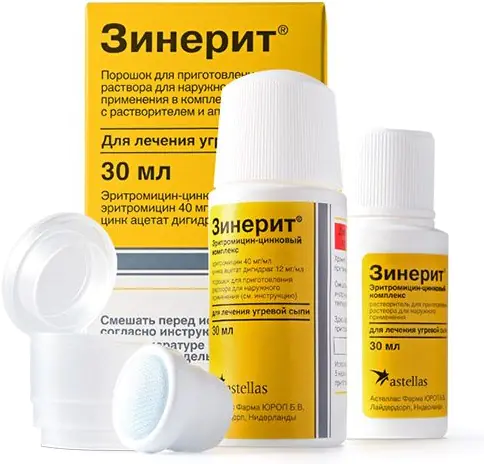
- Skinoren — the active component of the drug is azelaic acid. It is able to reduce the density of bacterial colonization that causes acne in all layers of the skin. The gel reduces the content of fatty acids in the epidermis and normalizes metabolic processes. The product is non-toxic and can be used externally on large areas of the skin. The skin is prepared for treatment by cleansing with running water and blotting with a towel. The drug is applied in a thin layer to problem areas, lightly rubbing. The duration of treatment is from 1 month to a year. The application regimen is prescribed by a dermatologist.
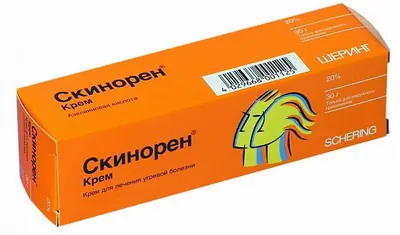
- Cynovitis (cream-gel) for acne. Components of the drug: licorice root, zinc, panthenol, lactic acid, shea butter, jojoba and olive. The product eliminates skin inflammation, irritation, and peeling. Regenerates cells, nourishes and has a moisturizing effect. Cleanses the skin and removes dead skin particles. The gel is applied pointwise and rubbed into problem areas. The procedure is repeated in the morning and evening until the acne completely disappears. After improvement occurs, treatment is continued for a week.
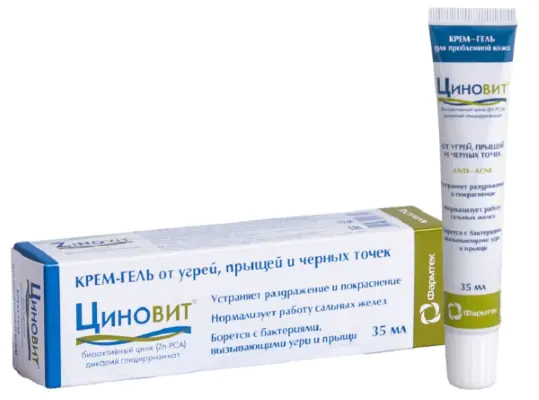
- Ichthyol ointment. Its main constituent substance is obtained from oil shale, thanks to which the product is saturated with vitamins and microelements. Treatment with medication is carried out on purulent acne, which can first be pierced with a treated needle. Then stick a patch soaked in ichthyol ointment to the inflamed area. Leave the application for 3 - 4 hours.
Vitamin and mineral complexes for acne
Vitamin intake is agreed with the treating dermatologist. They drink complex drugs containing all the necessary elements and narrow-acting drugs.
These are the following drugs:
- Aevit — vitamin A and E. A food supplement will relieve acne and heal wounds, improve metabolism, and regulate fluid content in the skin. It can be used not only internally, but also externally. To do this, the capsule with its contents is pierced and the oily substance is applied to the rash.
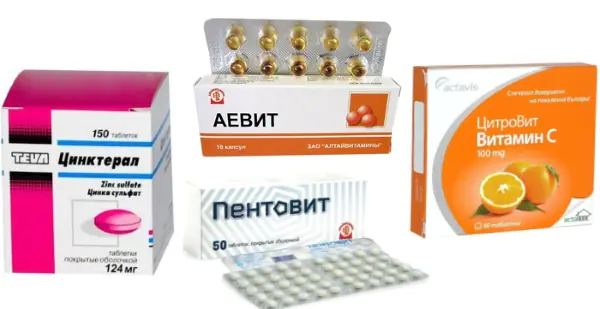
- Zincteral or Zinkovital - supplements with zinc. They normalize the functioning of the glands, remove toxins and cleanse the skin.
- Pentovit — B vitamins. Improve the appearance of the epidermis, hair and nails.
- Citravit - complex with ascorbic acid. Rejuvenates, makes the skin elastic, and protects against exposure to ultraviolet rays.
Cosmetological treatment methods
The procedures that are offered today in beauty salons are not much inferior in variety, depth of impact and effectiveness to medicinal methods.
A high-quality, timely consultation with a cosmetologist will help you choose the optimal treatment option, thanks to which you can eliminate acne for a long time.
List of procedures:
- Cleaning the skin. The procedure allows you to remove external manifestations, however, it does not destroy the cause. Therefore, it is used in complex treatment to eliminate internal factors for the appearance of a rash. Skin cleansing is carried out with ultrasound and high-frequency current. In the first option, dead layers of the epidermis are removed, pores are cleaned, and microcirculation in the vessels increases. Exposure to current helps relieve inflammation, destroy infection and smooth out scars.
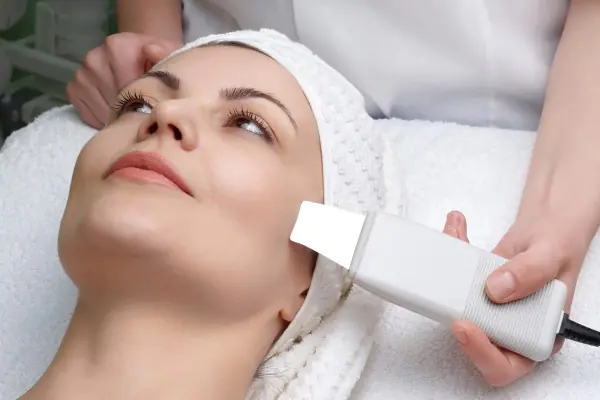
- Laser peeling — burning out the top layer of skin with a laser. The procedure is painful and requires long rehabilitation, but the effect lasts for 2-3 years. Benefits: eliminates acne and sebaceous plugs, tightens pores, enhances the production of elastin and collagen.
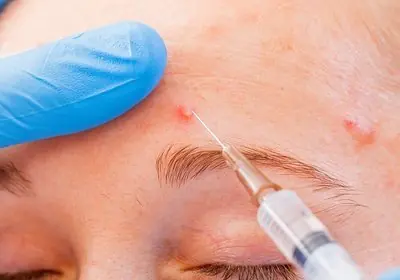
- Mesotherapy - injection of medications into areas of the skin covered with acne. Treatment involves the simultaneous use of antibiotics and antibacterial agents. Effective for suppuration and wen.
- Biodermabrasion - a combination of peeling based on chemical compounds and dermabrasion. First, the skin is coated with substances that include acids, vitamins and microelements, and then polished with diamond peeling. The results of the drugs are visible after the procedure is completed. It does not injure the skin, cleanses it, rejuvenates it and eliminates pigmentation.
Cleansing and steam baths
The procedure, which every woman can perform at home, perfectly cleanses the face and saturates dry skin with water and oxygen. Steam enriched with water softens the stratum corneum and makes it easier to remove, increases blood circulation, and activates glands and pores. Due to this, toxins and dirt accumulated in the lower layers of the epidermis are removed.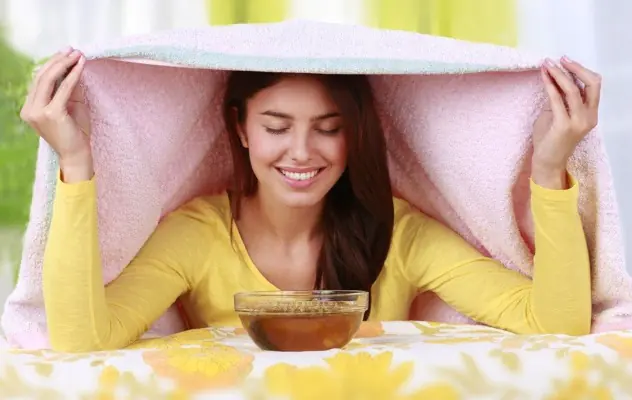
Tips for increasing the effectiveness of steam baths:
- If you add bay leaf to boiling water, it will increase circulation in the vessels.
- Licorice herb will remove toxins.
- Essential oils activate the brain. They have a relaxing effect on the body as a whole.
- A handful of celandine or burdock added to the container for the procedure will open the pores and disinfect.
- For those with dry skin, it is better to inhale with chamomile, and for oily skin with calendula.
The duration of the procedure should not exceed 25-30 minutes.
Folk remedies
The mask recipes presented below can, with constant use, eliminate rashes on the forehead
Blue clay mask
Reduces the visibility of rashes, and 3-4 applications will eliminate them completely.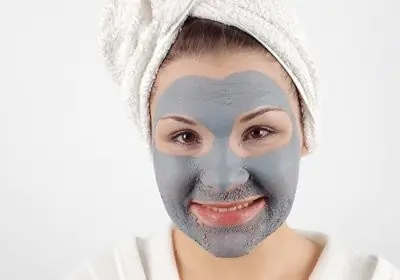
You will need:
- blue clay;
- 1 tsp lemon juice;
- 1 tsp alcohol tincture of calendula purchased at a pharmacy.
How to use:
- All ingredients are mixed until a paste is obtained.
- After the applied solution has dried, leave it on the face for 15 minutes.
- Removal from the skin is carried out by rinsing with warm water.
Protein mask
Dries out acne and heals wounds.
Ingredients for its preparation:
- vodka - 1 tbsp;
- iodine - 5 drops;
- egg white - 1 pc.;
- The white is beaten, iodine and vodka are added to it;
- The mask is applied in layers. Each subsequent one after the previous one has dried. 3 layers are enough;
- Leave for 20 minutes and rinse with cool water;
- I do the procedure 3 times a week. 5 masks are enough.
Aspirin with honey
Aspirin and honey can eliminate pimples on the forehead, influence the internal causes of their appearance in women, heal wounds, and smooth out dimples (pimples).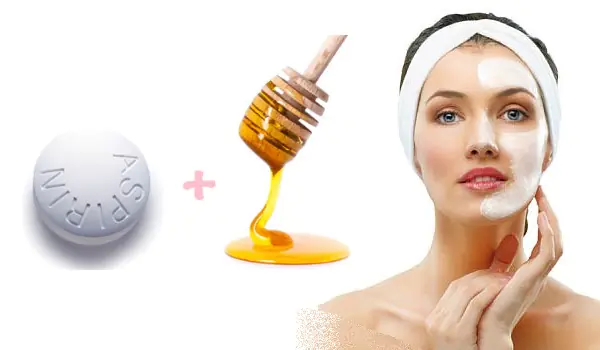
Sequencing:
- It is necessary to soften 2 aspirin tablets by dropping 2 drops of water on them;
- Mix the softened medication with 1 tbsp. l honey and apply to the forehead or the entire face for 15 minutes;
- The mask is washed off with warm water, and the skin is first cleaned with wet wipes soaked in chamomile concentrate.
Methods for getting rid of purulent and inflamed acne
Women should not ignore the appearance of rashes on the face, since the causes can be different. The rash can spread to other areas of the face. For example, ulcers form on the forehead, nose, chin, and cheeks.
A neglected purulent pimple can develop into a boil, which can only be removed surgically.
The following will help prevent rashes and eliminate existing ones:
- Take foods containing vitamin A daily.
- Cosmetic procedures - masks, peeling, facial cleansing are also effective in combating skin defects.
- Those with problem skin should not forget to use special lotions, masks and creams.
- Drinking a glass of water every day on an empty stomach will help remove toxins from the body and saturate the epidermis with moisture.
- Rubbing with apple cider vinegar diluted in 1 tsp of water will dry out weeping inflammations.
- It is better to replace tea and coffee with juices, fruit drinks, and jelly.
Daily walks in the fresh air, proper sleep, taking vitamin and mineral complexes, and psycho-emotional peace will help prevent acne from appearing on the forehead and eliminate the internal causes of rashes in women.
Article format: Svetlana Ovsyanikova
Video on the topic: acne on the forehead in women, causes of acne, treatment
Causes of acne on the forehead in women:
Why do acne appear on the forehead, methods of treatment:
The forehead is one of the favorite places for inflammatory elements to be located, be it small rashes or long-lasting subcutaneous pimples. Maybe give up flour or go for laser resurfacing? Let's figure out what causes acne on the forehead and what to do to get rid of the problem.
- Reasons for appearance
- Types of acne on the forehead
- Types of acne on the forehead
- How to get rid of acne on forehead
- Cosmetological methods
- Cosmetical tools
- Prevention
Reasons for appearance
Pimples on the forehead are a problem that almost everyone has encountered. But while for some they passed quickly and without a trace, for others they suffered greatly. Pimples (or acne) should be treated by a dermatologist, and the cause of their appearance may be hormonal imbalance or high sensitivity of the sebaceous glands to their own hormones.
Pimples on the forehead in teenagers. A surge in hormonal activity during puberty leads to increased production of sebum, which clogs sebaceous ducts and clogs pores, which causes the formation of comedones: open (blackheads) and closed (pimples). Often it is on the forehead - in the area where the concentration of sebaceous glands is especially high. Usually the problem disappears on its own when a person reaches a “tender” age. However, you shouldn’t ignore it, especially since today entire lines are being produced to care for skin with acne.
Pimples on the forehead in women. The activity of the sebaceous glands is associated with hormonal fluctuations. Imbalances caused by age-related changes can also cause rashes on the forehead. To control and correct hormonal levels, you need to consult a doctor, but we must not forget about thorough cleansing of the skin and appropriate care.
Pimples on the forehead in men. Men's skin is naturally oilier and thicker, which means it is more prone to breakouts. Plus, it is male hormones (androgens) that stimulate the activity of the sebaceous glands, especially in the T-zone, which includes the forehead. Therefore, men need to take a very responsible approach to skin care, in particular to cleansing it.
Isolated inflammations sometimes occur for everyday reasons, the main ones of which are listed below.
Inappropriate cosmetics
To prevent your skin from reacting with “blooming” to a new cream, choose products labeled “non-comedogenic.” Pay attention to the texture: thick nourishing creams are good in winter, light fluids are good in summer.
Poor nutrition
Acne can appear from exposure to aggressive cosmetics. © Istock
Carelessness in everyday life
Do you dry your hands and face with the same towel? Letting your pet sleep on your pillows? Do you keep your brushes in your makeup bag and wash them once a week? Do you often sit with your chin resting on your palm? All this can worsen your skin condition.
Illiterate skin care
Skin overdried by aggressive cosmetics begins to secrete even more sebum in order to protect itself, that is, the effect will be exactly the opposite of what you wanted to achieve.
To avoid this, moisturize your skin more often - especially after sunbathing, using cleansing masks, or when using acid-containing products and retinoids in care.
Cell renewal with exfoliants is one of the key components of your beauty routine if you want to achieve even skin tone and texture. Exfoliants speed up exfoliation, which normalizes sebum production.
Types of acne on the forehead
In this area, different elements can be distinguished: comedones, papules, pustules. This skin condition can be accompanied by an oily sheen, sallow color and uneven texture.
Squeezing pimples yourself is dangerous. © Istock
How to find out the severity of the problem? If a couple of uninvited guests visit you before your period, there is no reason to worry. It’s another matter when your entire forehead is covered in pimples or you observe persistent subcutaneous inflammation.
Visit a dermatologist, he will prescribe the necessary tests.
If necessary, make an appointment with a gynecologist-endocrinologist and gastroenterologist.
A cosmetologist will help if the situation is far from catastrophic: he will recommend a skin care program and, possibly, carry out procedures.
Types of acne on the forehead
Let's take a closer look at what acne can look like in this area.
Comedones (blackheads)
Papules
Papules are dense red formations that appear due to blockage of the canal and the accompanying inflammatory process; they are also called subcutaneous or internal acne. You shouldn’t remove them yourself if you don’t want to end up with a scar or age spot.
Pustules
Pustules are spherical inflammations with a white head that can be painful. They are effectively dealt with by targeted drying agents based on salicylic acid.
Nodules and cysts
Occurs in severe forms of acne. Sebaceous plugs form nodes (inflammations with a diameter of more than 1 centimeter), which then grow together into cysts and are difficult to treat with home methods. Serious measures will help to defeat them: the use of antibiotics and retinoids in combination with procedures from a dermatologist and/or cosmetologist.
How to get rid of acne on forehead
Try to follow these simple rules and soon you will most likely notice positive changes in the condition of your skin.
Oily skin needs hydration no less than dry skin. © IStock
Check out your makeup bag. If the inflammation is small and caused by the introduction of a new product, for example, a cream, temporarily discontinue it and look at the result. Sometimes it’s a matter of the comedogenicity of the formula, and sometimes it’s a matter of individual intolerance to the components.
Leave the cleaning procedure to a professional. Cleaning your face on your own can lead to more breakouts and worsen your skin condition.
Maintain good hygiene. Wash your makeup brushes regularly, change your pillowcases at least once a week, and replace cloth face towels with paper ones.
Cleanse your skin the Asian way. For Korean women, for example, the first stage of skin cleansing is makeup removal using hydrophilic oil and/or micellar water. And only then - cleansing the skin with a gel or foam cleanser.
Cosmetological methods
If you are only bothered by a couple of inflammations during PMS, it is hardly worth going to a cosmetologist. But for those who have more serious problems, specialists may suggest one of the procedures described below.
Laser resurfacing
Being a direct descendant of dermabrasion, laser resurfacing also works on the principle of mechanical damage: the microburn effect causes accelerated exfoliation in the treated area and stimulates cellular renewal.
Chemical peeling
Such peels are carried out using acids (glycolic, lactic, azelaic, salicylic) or retinoids. These components can accelerate the process of cellular renewal.
Attention: the rehabilitation period after medium chemical peels takes a lot of time - up to a week - and is accompanied by severe peeling of the skin, irritation and redness.
Cosmetical tools
Let's take a closer look at the different types of cosmetics that you should pay attention to when acne appears on the forehead and for their prevention.
Moisturizer or serum
Clay-based cleansing mask
Clay perfectly absorbs dirt and sebum, cleansing pores. Using clay masks 1-3 times a week, within a month you will notice an improvement in the quality of your skin and a decrease in the number of inflammatory elements.
Exfoliants
Mechanical exfoliants (scrubs) should not be used on skin with inflammatory elements. When using chemical exfoliants (with acids, retinoids), special attention must be paid to sun protection, because these components increase the skin's sensitivity to ultraviolet radiation.
Prevention
There are a number of cosmetics that help prevent rashes on the forehead and other areas of the face.
Apply morning and evening to previously cleansed facial skin, spreading the texture with your fingers.
Salicylic acid renews the skin and has an anti-inflammatory effect, probiotic bif >.
Use on cleansed face morning and evening, avoiding the eye area.
Green tea is a natural antioxidant that protects skin cells from free radicals. Zinc regulates sebum production.
Use once a day after cleansing the skin. You can apply moisturizer on top.
Salicylic acid helps exfoliate dead cells, reduces skin oiliness, preventing the formation of inflammatory elements, and vitamin B3 softens the skin and works as an antioxidant.
Apply a thin layer to face after cleansing and toning.
The natural mineral perlite absorbs excess sebum, and sebulis regulates its production.



